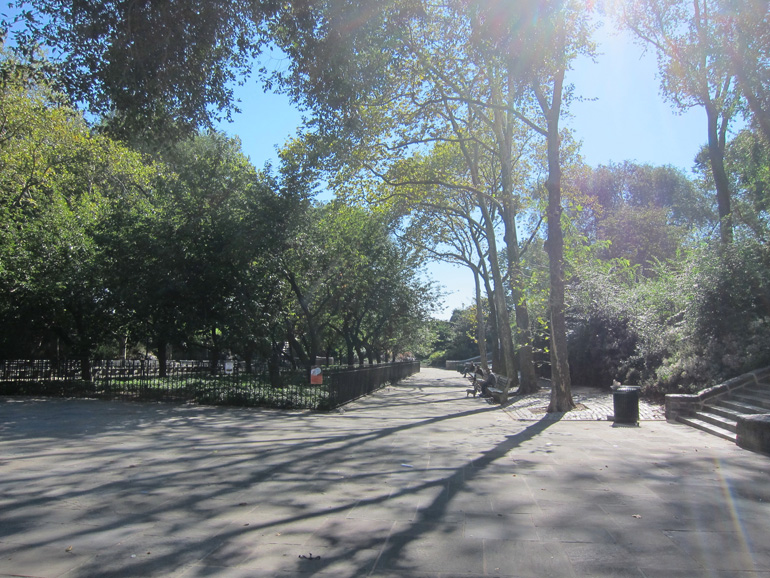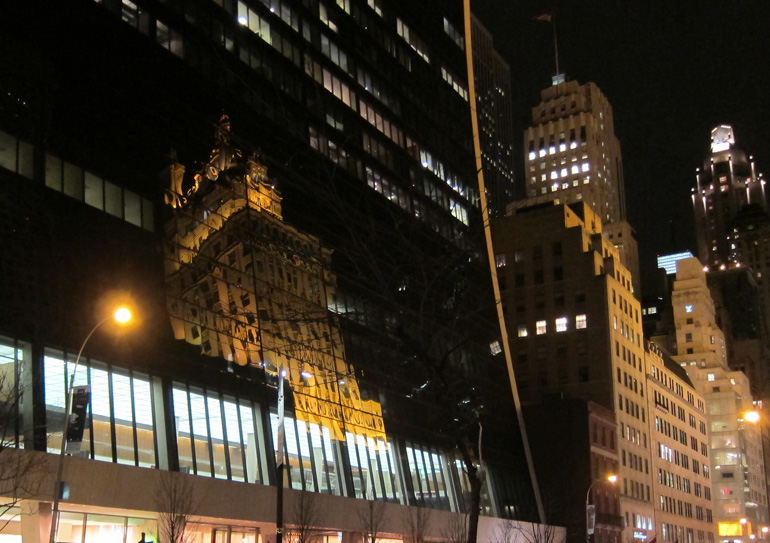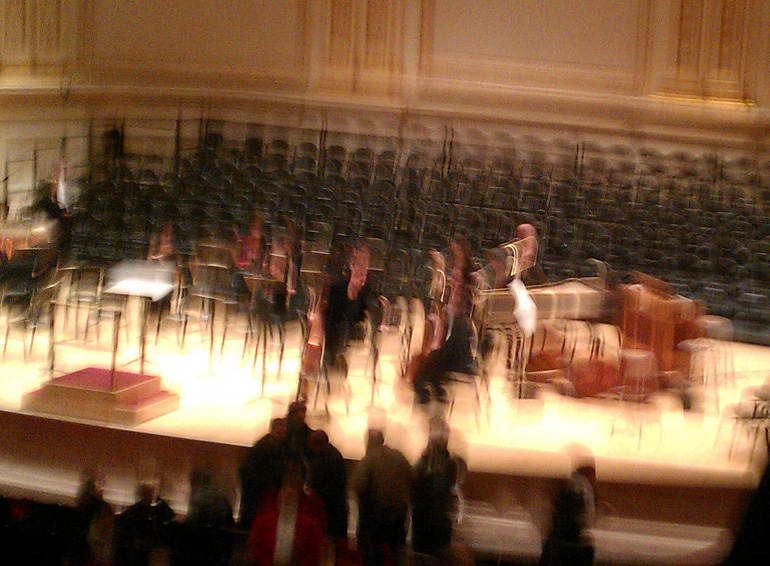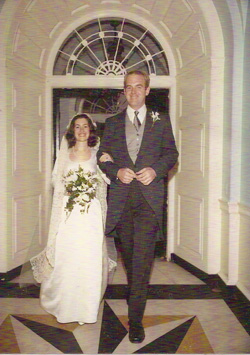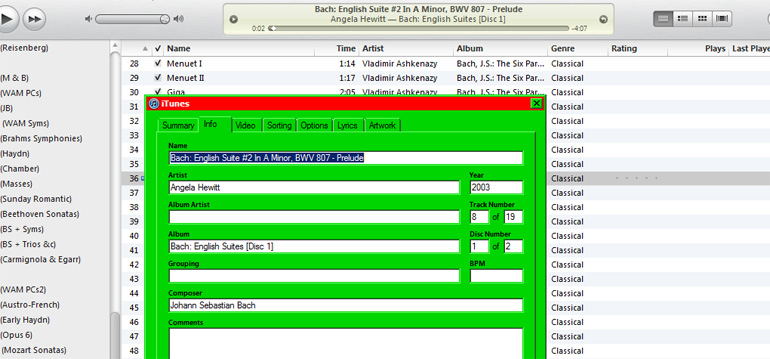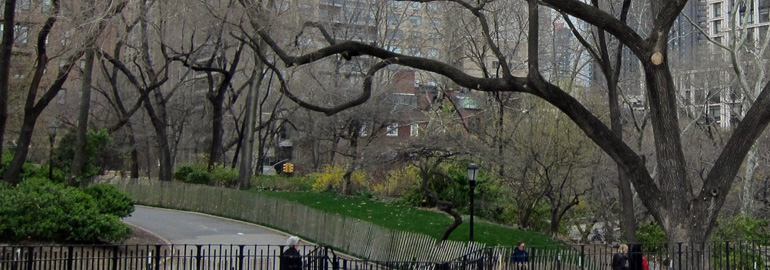Gotham Diary:
At the Dinner Store
6 December 2012
Thursday, December 6th, 2012
Last night, at the coffee shop across the street that Will calls “the dinner store” — an insight of genius for which I would praise him to the skies if I were certain that it’s altogether his own — I needed to break a bill for the tip. I told Will to sit still and went to the cash register at the front of the shop. When I came back to the table, in the rear, there was no Will. There was no nobody. A dust cloud of panic swirled up, and the only definite concern that I can retrieve from it now is that Will might somehow have been abducted into the kitchen. (Self-abduction being a possibility.) Regular readers will recall that I had a dreadful nightmare along these lines just a few days ago. Awake, it seems, I’m not so easily dread’s captive. It hit me that I was dealing with Will. A glance under the table revealed a number of potentially moving parts. “You little stinker,” I snorted. Later, his mother would tell me that he’s been doing this a lot lately, hiding “too well.” So it will be more out of concern for myself than from fear for Will’s safety that I’ll be keeping closer tabs on him when he’s in my charge.
For the time being, it is possible to entice Will into almost anything if pressing an elevator button is involved. Just one button, mind. Although he’s delighted to push the button for your floor, if you ask him. He has to be shown which one to push; what looked a lot like numeracy six months ago turned out to be a (familiar, well-documented) mirage.
Do you remember the Jane Austen action figure that I picked up a while back? I had to have one, after Rachel Brownstein used one for the dust-jacket of her recent book about Austen. Will never fails to pick this up when he passes by it, because he can tell that it is an action figure. He also thinks that it’s a guy — you know what superhero drag is. I’m disabusing him of that. I told him last night that Jane Austen was a “writer,” but then, worrying that this sounded far too much like “rider,” I said, with painstaking enunciation and emphasis, that “she wrote books. And the quill pen was her weapon.” I think that I’d better buy another action figure, just to have in a drawer when something action-related happens to the one I’ve got. (But wait! A replacement will cost a fortune!) The beauty part, was hearing him repeat her name, as he does almost every new word that he hears, softly but intelligibly. Hearing him breathe “Jane Austen” made me feel very — silly.
***
I complain all the time about going out in the evening: it’s something that I don’t want to do anymore. That’s why I felt almost honor-bound to get myself over to the Museum yesterday for an afternoon concert in the musical instruments galleries. Wei-Yang Andy Lin gave an erhu recital to a packed audience — well, forty or fifty folding seats, arrayed at one end of the long and narrow Mertens gallery, were packed. Andy Lin is perhaps the best violist that I’ve ever heard (I’ve written about him somewhere, perhaps at Portico), and it’s not surprising that he makes the erhu sound lovely, too. To be perfectly blunt: he plays the instrument with such skill that its exotic qualities (read: limitations) are swallowed up by a thoroughly Western musicianship. Had Mahler heard Andy play, there would be an erhu part in Das Lied von der Erde.
My knowledge of Chinese music is as limited as you like; I really know nothing about it save what I’ve heard in the movies. But I gathered that the seven pieces that Andy Lin played are part of an ongoing, evolving tradition that has not been uunaffected by the pull of Western diatony. Composers were not identified; it may be that there are none, as such — that pieces such “Birds Singing in the Empty Mountain” and “Parting after the Newly-Married” are closer to jazz standards, musical concentrates that the performer fleshes out in his or her own idiom. (I must look into this!) I will say, though, that while it might have been reasonable to fear forty-five minutes of Chinese-opera screeching, the gallery was filled instead with the sounds of music both mellow and engaging. There was a fair amount of bravura trompe l’oreille (“onomatopoeia” wouldn’t do it justice) — those “Birds,” the horses in “Horse Racing” and “Horses Running on a Battle Field.” But “Loved Lonely Flower” sang a song that was almost Central European in its post-Romantic melancholy. And “Parting after the Newly-Married,” which captures the dismay of a bride whose husband has been conscripted the day after the wedding, was a dramatic scena without voice. Or, rather, with the voice of Andy Lin’s erhu. This was sophisticated but accessible music. Not the faintest whiff of broccoli.
***
Two items in this morning’s reading had me mulling over the conundrum labeled “nation.” One, in the Times, concerned the “often overlooked” role of the oligarchy in Greece’s fiscal woes. Two years ago, Christine Lagarde, then French finance minister, compiled a list of over two thousand Greeks thought have bank accounts at a Swiss bank. In Greece itself, this list was “swept under the rug,” writes Rachel Donadio. (Surprise, surprise.) In the other piece, in The Nation, Gary Younge writes about “Secessionist Fantasies,” here and in Europe.
In Europe, it is partly history’s revenge on rhetoric. The emergence of the nation-state as the single most effective economic and political unit over the past two centuries necessitated a confected patriotism that sought either to iron out or ignore regional differences. This meant reimagining countries not as the product of regional alliances, wars or necessity but as an incarnation of innate genius born from essential characteristics. “We have made Italy,†said Massimo d’Azeglio at the first meeting of the newly united Italy’s infant parliament. “Now we must make Italians.†But while those differences were eclipsed, they were rarely eliminated.
That’s putting it mildly. Tara Zahra, in a review appearing in the same issue, explores the postwar ethnic cleansing that attacked the Volksdeutsch, German-speakers living outside the (new) German border, reminds us of the American role in the disasters of which this was only the latest:
But for the victors’ calculations to be understood entirely, we actually have to turn back the clock even further, to the end of World War I. Woodrow Wilson arguably bears as much responsibility as Stalin, Churchill, Roosevelt and Czechoslovakia’s president, Edvard BeneÅ¡, for the postwar spree of ethnic cleansing. In 1918, the remnants of the multinational Habsburg and Ottoman empires were carved into sovereign nation-states, in accordance with the Wilsonian ideal of “national self-determination.†As Hannah Arendt perceptively argued, the world stood convinced in 1918 that “true freedom, true emancipation, and true popular sovereignty could be attained only with full national emancipation, and that people without their own national government were deprived of human rights.â€Â
The problem with this principle was that borders and nations were not neatly aligned in Eastern and Central Europe. Citizens of the Habsburg Empire’s many linguistic, national and confessional groups were hopelessly intermingled. In many cases it was not even clear who belonged to what nation, because so many citizens of the empire were bilingual or indifferent to nationalism. Equally important, in spite of the rhetoric of national self-determination, the frontiers of the new successor states had been drawn with geopolitical imperatives in mind. Even though German speakers formed an absolute majority in the borderlands of Czechoslovakia (which would come to be known as the Sudetenland), and most wanted to join the Austrian rump state, the region was forcibly annexed to Czechoslovakia for the sake of the state’s economic viability.Â
The fact is — and citizens of the United States ought to appreciate this better than most — that the idea of the nation has never had much of a foundation outside the realm of sentiment. As a sentiment, it works pretty well: American children are (or used to be) brought up to respect the nation’s symbols, which are by and large inclusive and free of identity baggage. “Born in the USA” is all it takes. (Geographical isolation helps.) Strong national sentiment (“patriotic” is the preferred synonym; “nationalism” is for other people) made it easy for generations of Americans to overlook the ugliness of slavery and segregation — but then so did skin color. The toxicity of European nationalism springs from the difficulty of detecting “the other,” someone who might look just like you, giving himself away when he opens his mouth and speaks Walloon instead of Flemish. (How long does it take a Sunni Muslim to spot a Shiite?) American oppression of blacks was dreadful, but the status quo was largely free of the hate that fear of the invisible promotes.
It will be interesting, if we get to live so long, to see how future generations of Muslim immigrants assimilate into the textures of Northern Europe’s populations. There is every reason to expect that the lucky educated few will shed sectarian fervor, while the disadvantaged many will cling to Islam for the same reason that American immigrants supported Tammany Hall and tolerated protection rackets. But that overlooks any new wrinkles that might be in store. How long, one wonders, will the Maghrib and the Middle East remain pervasively unprosperous? Longer than it will take the Greeks on the Lagarde list to cough up?Â


